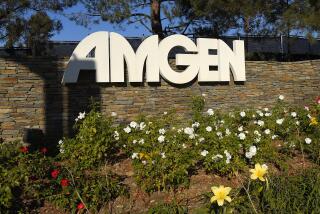Amgen Research Show Disappoints Investors
NEW YORK — Amgen Inc. gave Wall Street a long-awaited look at its drug-development pipeline Tuesday, and investors were underwhelmed.
The biotech company showcased 24 development programs aimed at a broad range of illnesses, including cancer and diabetes, as well as chronic pain. Included in the mix was a medication for osteoporosis that Amgen said appeared to be better than Merck’s Fosamax and had blockbuster sales potential.
But analysts said investors felt let down because Amgen didn’t make a major announcement during the five-hour session, which marked the first time the Thousand Oaks-based firm had ever lifted the veil on its research-and-development efforts.
The company’s stock fell nearly 4%, losing $2.28 to close at $57.83 on Nasdaq.
Wall Street had expected Amgen “to pull a rabbit out of a hat,” said Geoffrey Porges of Sanford C. Bernstein & Co. “Instead they pulled out some guinea pigs.”
Analysts said it was difficult to assess the prospects for many of the Amgen drugs, considering that the medications still faced several years of testing.
Investors also were disappointed that Amgen was unable to provide reassurance about changes in Medicare reimbursements for some of the company’s key drugs. The Center for Medicare and Medicaid Services is expected to reduce next year what it pays for Epogen, an anemia treatment and Amgen’s bestselling product. The reimbursement for three other key Amgen drugs will change in 2005 as a result of the new Medicare reform law.
Amgen is under pressure from Wall Street to maintain annual earnings growth in the 20% range. To do so, the company must boost revenue by several billion dollars each year. Total revenue was $8.36 billion last year.
Chief Executive Kevin Sharer told investors Tuesday that, barring drastic steps by the Medicare agency, the company would meet its 2005 financial goals.
At a news conference, he chided Wall Street for focusing on short-term stock gains.
“I am sure there were people who thought we’d pull a rabbit out of a hat and somehow surprise them,” Sharer said. “We didn’t schedule this meeting to get a short-term pop in the stock.”
Amgen shares have slumped from a 52-week high of $71.54 in July; they’re now nearly unchanged from their level one year ago. By contrast, an American Stock Exchange-sponsored index of 17 major biotech stocks, including Amgen, is up 50% from a year ago.
The star in Amgen’s pipeline is AMG 162, a medication that shows promise in osteoporosis and certain types of cancer. Sharer told reporters that it “has all the hallmarks of a molecule that could have a very big future.”
Amgen said potential sales of the drug for cancer and for osteoporosis exceeded $1 billion a year in each category.
The company’s R&D; chief, Roger Perlmutter, told investors that AMG 162 performed as well or better than Fosamax in the second round of human tests required for Food and Drug Administration approval. A third round remains.
Perlmutter said the drug might slow the spread of cancer to the bones, and the company plans to begin testing AMG 162 in that disease this year.
Amgen also reported that it had some setbacks. A diabetes drug that Amgen licensed from a Swedish company for more than $80 million last summer did not pass muster in a small clinical trial. Perlmutter said Amgen must conduct additional lab studies to understand how the drug works before testing it again in people.
Perlmutter said he wasn’t disappointed with the drug, called 11B-HSD1.
“Every drug dies 1,000 deaths” before reaching the market, he said. “This one isn’t even mortally wounded.”
The company also scraped a rheumatoid arthritis pill aimed at a protein called p38 -- an elusive target that several companies have been trying to hit. Amgen said it was developing another pill aimed at the same target.
Amgen also revealed Tuesday that it was developing drugs that slow blood-vessel growth in cancerous tumors and slow production of B cells, a type of white blood cells -- areas now dominated by South San Francisco-based Genentech Inc.’s cancer medications Avastin and Rituxan. Though Amgen is years behind its rival, some analysts said battle lines had been drawn. “I think we will see competition heat up between the two,” Porges said.
Still, analysts’ overall impression of Amgen’s first-ever R&D; presentation was unimpressive. “The take-away,” said Jennifer Chao of RBC Capital, “was that there was not anything particularly riveting.”
More to Read
Inside the business of entertainment
The Wide Shot brings you news, analysis and insights on everything from streaming wars to production — and what it all means for the future.
You may occasionally receive promotional content from the Los Angeles Times.










